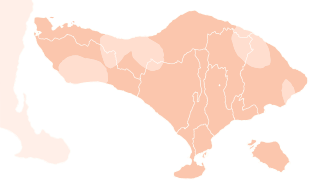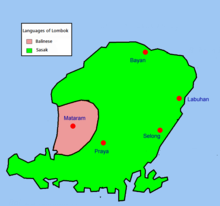Balinese is a Malayo-Polynesian language spoken on the Indonesian island of Bali, as well as Northern Nusa Penida, Western Lombok, Eastern Java,[3] Southern Sumatra, and Sulawesi.[4] Most Balinese speakers also use Indonesian. The 2000 national census recorded 3.3 million people speakers of Balinese, however the Bali Cultural Agency estimated in 2011 that the number of people still using the Balinese language in their daily lives is under 1 million. The language has been classified as "not endangered" by Glottolog.[2]
| Balinese | |
|---|---|
| ᬪᬵᬱᬩᬮᬶ / ᬩᬲᬩᬮᬶ1 Bhāṣa Bali / Basä bali1 | |
| Native to | Indonesia |
| Region | Bali, Nusa Penida, Lombok, Java |
| Ethnicity |
|
Native speakers | 3.3 million (2000 census)[1] |
Early form | Old Balinese |
| Dialects |
|
| Latin script Balinese script | |
| Official status | |
| Regulated by | Badan Pengembangan dan Pembinaan Bahasa |
| Language codes | |
| ISO 639-2 | ban |
| ISO 639-3 | ban |
| Glottolog | bali1278 |
 Balinese is a majority language where vast majority are first language speakers Balinese is a spoken language or being spoken as second language only Balinese is a minority language | |
 | |
The higher registers of the language borrow extensively from Javanese: an old form of classical Javanese, Kawi, is used in Bali as a religious and ceremonial language. Apart from being spoken in Bali, Balinese is also widely spoken on the island of Lombok, especially western part of Lombok island, and to a small extent it is also spoken on the island of Java, especially Banyuwangi. and western part of Sumbawa island. The spread of the Balinese language on these islands cannot be separated from the history between the islands.
Classification
Balinese is an Austronesian language belonging to the Malayo-Polynesian branch of the family. Within Malayo-Polynesian, it is part of the Bali–Sasak–Sumbawa subgroup.[5] Internally, Balinese has three distinct varieties; Highland Bali, Lowland Bali, and Nusa Penida.[2]
Demographics


According to the 2000 census, the Balinese language is spoken by 3.3 million people in Indonesia, mainly concentrated on the island of Bali and the surrounding areas.
In 2011, the Bali Cultural Agency estimated that the number of people still using the Balinese language in their daily lives on Bali Island does not exceed 1 million, as in urban areas their parents only introduce the Indonesian language or even English as a foreign language, while daily conversations in the institutions and the mass media have disappeared. The written form of the Balinese language is increasingly unfamiliar and most Balinese people use the Balinese language only as a means of oral communication, often mixing it with Indonesian in their daily speech. However, in the transmigration areas outside Bali Island, the Balinese language is extensively used and believed to play an important role in the survival of the language.[6]
Phonology
Vowels
| Front | Central | Back | |
|---|---|---|---|
| High | i | u | |
| Mid | e | ə | o |
| Low | a |
The official spelling denotes both /a/ and /ə/ by ⟨a⟩. However, ⟨a⟩ is usually pronounced [ə] when it ends a word, and [ə] occurs also in prefixes ma-, pa- and da-.[7]
Consonants
| Labial | Alveolar | Palatal | Velar | Glottal | ||||||
|---|---|---|---|---|---|---|---|---|---|---|
| Nasal | m | n | ɲ | ŋ | ||||||
| Stop/Affricate | p | b | t | d | tʃ | dʒ | k | g | ||
| Fricative | s | h | ||||||||
| Approximant | w | l | j | |||||||
| Trill | r | |||||||||
Depending on dialect, the phoneme /t/ is realized as a voiceless alveolar or retroflex stop. This is in contrast with most other languages in western Indonesia (including Standard Indonesian), which have a dental /t/ patterning with an otherwise alveolar phoneme series.[4]
Stress
Stress falls on the last syllable.[7]
Vocabulary
Registers
Even though most of the basic vocabulary in Balinese and Indonesian are of Austronesian and Sanskrit origin, many cognates in both languages sound quite different.[8] Balinese has different registers depending on the relationship and status of those speaking: low (basa ketah), middle (basa madia), and high (basa singgih). Basa singgih contains many loanwords from Sanskrit and Javanese (specifically Old Javanese) which reflect the fifteenth-century usage spoken by Old Javanese. The common mutations in inherited Balinese words are:
- First, mutation r into h of initial r, intervocalic r, and final r
- Second, h into ø, everywhere except the final consonant
However, these mutations are not expressed by the High Balinese, thus this infer high Balinese was loanwords from Sanskrit and (Old) Javanese. These loanwords are identical in sound with their Javanese cognates.[9]
| English | Low Balinese | High Balinese | Indonesian | Old Javanese | Javanese |
|---|---|---|---|---|---|
| this | éné | niki | ini | iki | iki (ngoko), punika (krama) |
| that | énto | nika | itu | ika | |
| here | dini | driki | di sini | ||
| there | ditu | drikä | di sana, di situ | ||
| what | apä | napi | apa | apa | |
| human | manusä, jelemä | jadmä | manusia | jadma | manungsa |
| hair | bõk | rambut | rambut | rambut | rambut |
| fire | api | gni | api | gĕni | geni |
| child | pañak | pianak, okä | anak | ||
| to live | idup | urip | hidup | urip | urip |
| to drink | nginém | nginém | minum | manginum | |
| big | gédé | agéng | besar, gede | gĕḍe | gedhé |
| new | baru | anyar | baru | (h)añar | anyar |
| day | wai | rahinä | hari | rahina | dina, dinten |
| sun | matan ai | suryä | matahari | surya | ari |
| lake | danu | tlagä | danau | ranu | tlaga |
| egg | taluh | taluh | telur | ĕṇḍog | endhog (ngoko), tigan (krama) |
| friend | timpal | suwiträ | teman | kañca, mitra, sakhā | kanca, kenalan, mitra |
| to sightsee | mélali-lali | malélancarañ | tamasya | ||
| name | adan | parab,Wastan | nama | (h)aran, parab | aran, jeneng (ngoko), wasta (krama), asma (krama inggil) |
| to be, to become | dadi | dados | menjadi | ||
| to stay | nongos | meneng | tinggal | ||
| from | uling | saking | dari |
Numerals
Balinese has a decimal numeral system, but this is complicated by numerous words for intermediate quantities such as 45, 175, and 1600.
Grammar
The word order is similar to that of Indonesian, and verb and noun inflectional morphology is similarly minimal. However, derivational morphology is extensive, and suffixes are applied to indicate definite or indefinite articles, and optionally to indicate possession.[7]
Writing
Balinese has been written in two different writing systems: the Balinese script, and in modern times the Latin script.
Balinese script

Note: The script is arranged in Javanese order.
The Balinese script (Aksara Bali, ᬅᬓ᭄ᬱᬭᬩᬮᬶ), which is arranged as Hanacaraka (ᬳᬦᬘᬭᬓ), is an abugida, ultimately derived from the Brāhmī script of India. The earliest known inscriptions date from the 9th century AD.[10]
Few people today are familiar with the Balinese script.[11] The Balinese script is almost the same as the Javanese script.
Latin alphabet
Schools in Bali today teach a Latin alphabet known as Tulisan Bali.[12]
Gallery
- Balinese palm-leaf manuscript
- Sign at Pura Puseh Temple, Batuan, Bali
- Page from a Bible printed with Balinese script
- Street sign in Singaraja, written in Latin and Balinese script
- Klungkung Regent's Office sign
- Lontar manuscript restoration
Note
^1 In Balinese script, Sanskrit and Kawi loanwords tend use conservative orthography as standard form in Balinese script. The word for language, basa, in Balinese is a loanword from Old Javanese bhāṣa which came from the Sanskrit word भाषा bhāṣā, hence it is written according to Sanskrit and Old Javanese spelling ᬪᬵᬱᬩᬮᬶ in Balinese script. The Bali form in Balinese script is used by beginner writers. Meanwhile, diacritics are not written in the current romanization of the Balinese language. Thus, both Bali and basa Bali are the standard forms.
See also
References
External links




- Ager, Simon. "Balinese". Omniglot. Archived from the original on 9 March 2007. Retrieved 2007-03-07.
- The Balinese Digital Library.
- Widiadana R. A. & Erviani N. K. (29 January 2011). Ancient 'lontar' manuscripts go digital Archived 2011-08-06 at the Wayback Machine. The Jakarta Post.
- Erviani N. K. (14 January 2011). US scholar brings ancient Balinese scripts to digital age. The Jakarta Post.
- Unicode website
- Paradisec open access recording of Balinese song.
- Kaipuleohone's Blust collection includes materials on Balinese, including RB2-006,RB2-009.






